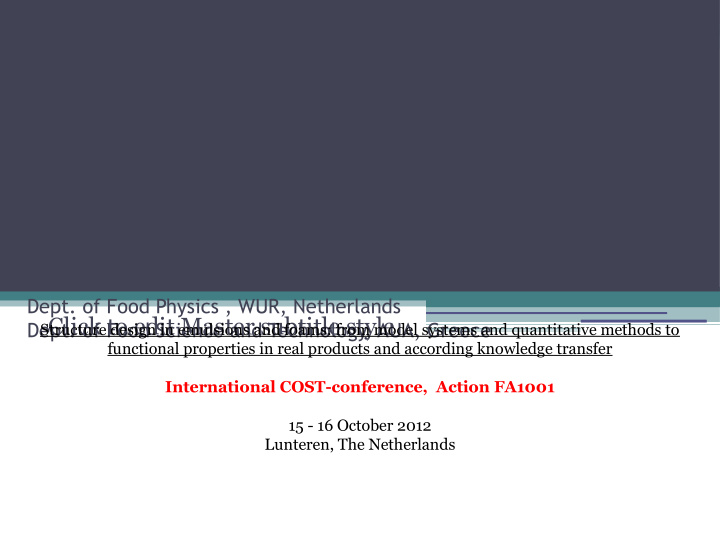



“ O/W sub-micron emulsions prepared with whey protein-Tween 20 combinations and layer-by-layer pectin addition” Olga Kaltsa, Evi Paximada, Elke Scholten, Stavrianos Yianniotis, Ioanna Mandala Dept. of Food Physics , WUR, Netherlands Click to edit Master subtitle style Dept. of Food Science and Technology, AUA, Greece Structure design in emulsions and foams: from model systems and quantitative methods to functional properties in real products and according knowledge transfer International COST-conference, Action FA1001 15 - 16 October 2012 Lunteren, The Netherlands
Reducing oil droplet size restrictions High shear • reduce the viscosity of stabilizers (80-90%) US, HP
Effect of sonication on viscosity of Xanthan Viscosity properties as affected by sonication • treatment Sonication k n treatment (Pa-s^n) (-) No Ultra 24.00 0.181 40%-1min 11.16 0.196 60%-1min 4.37 0.309 80%-1min 3.18 0.331 34 100%-1min 2.58 0.354 70%-1min 4.12 0.308 70%-2min 2.38 0.359 70%-3min 1.49 0.420 70%-4min 0.704 0.503 Influence of sonication treatment on the viscosity of 1% XG solutions. (100%-1min) similar effect with (70%-2min) 10 times reduction of K, • 3 times increase of n (less shear-thinning) •
Objectives • Minimize the size of olive oil droplets by WPI-Tween20 combinations/stability at low oil fractions • Establish a z-potential value that pectin-WP electrostatic interactions could be favored • Pectin addition: modifying aqueous phase viscosity against creaming/by dilution to overcome viscosity reduction during HP • Assess the stability of prepared emulsions with different methods/MLS (Turbiscan) (storage),
Emulsion preparation Coarse emulsion (WPI)-Tween20 1:0, 3:1, 2:2, 1:3, 0:1 (1% total emulsifier) Primary emulsion + Extra virgin olive oil 10% Secondary emulsion 0, 0.2, 0.4 and 0.6% Pectin 6% olive oil pH 3.3 + Pectin (high shear 16.800RPM/2min) (HP 200 bar, 8.5 min)
Droplet size of primary emulsions sub-micron emulsion produced § for 2:2, 1:3 & 0:1 ratios (D90~600-700nm) Tween20strongly decreased § D32 Monomodal distributions Tween § ratios< 2:2 1:0 &3:1 ratios, high polidispersity § (D90~2-5μm) Fig. Influence of WPI-Tween combinations on particle size of primary emulsions
Surface charge 12 1:0 3:1 2:2 1:3 0:1 10 8 z-potential (mV) Δz 6 4 2 0 WPI-Tween ratio Influence of pectin concentration on surface charge per combination of WPI-Tween20 0% Pectin:WPI decreasez-potential +36.2mV to -2.5 § negative surface charge, concentrationminor influence per ratio Pectin addition Δz decreased per ratioless pectin attached § to protein
Creaming stability (by MLS*) high WP Influence of pectin concentration on phase Phase separation evolution during cold storage for separation 2:2 WPI-Tween20 ratio § 0% pectincreaming =ƒ(droplet size & z-potential) § (2:2) max. stability at 0.4% pectin § 1:3 & 0:1 high instability depletion flocculation, improved by viscosity increase *Multiple Light scattering (Turbiscan)
Creaming rate (centrifugation) Influence of pectin concentration on creaming rate of 1:0 & 0:1 WPI-tween20 ratios § 1% WPIhigh pectin concentration decreased creaming § 1% Tween20 opposite effect, depletion flocculation
Creaming rate (centrifugation) WPI-Tween20 (2:2) § 0.6% pectin Stability trend not in agreement with MLS method § Centrifugation: good correlation for viscosity increase and depletion flocculation Influence of pectin concentration on creaming rate § Is there another at 2:2 WPI-Tween20 ratio phenomenon occuring?
Bulk rheology 12 12 0.2% 10 10 8 8 6 6 Apparent viscosity (Pa-s) Apparent viscosity (Pa-s) 4 4 2 2 0 0 1 10 100 0,1 1 10 100 Rate (1/s) Rate (1/s) 0.4% 0.6% Influence of pectin concentration on apparent viscosity of WPI-Tween20 ratios
Bulk rheology WPI-Tween20 (2:2) § Low pectin concentration high WP ratios, high low-shear viscosity § 0.6%newtonian for 1:0, 3:1 and 2:2, slight increase flocculation for high Tween ratios Influence of pectin concentration on apparent viscosity of WPI-Tween 2:2 ratio § Liquid like- emulsions
Microstructure 0% pectin 0.2% pectin (2:2) ratio 0.4% pectin 0.6% pectin
Conclusions • Droplet size significantly decreased at high • Stability method MLS-centrifugationresults Tween concentrations (>2:2) not in accordance at 2:2 ratio • Best combination for increased stability – reduced droplet size 2:2 WPI-Tween, 0.4% WPI displacement by Tween (z-potential during storage, protein content at the aqueous phase)
Thank you! Questions? • This research has been co- financed by the European Union (European Social Fund – ESF) and Greek national funds through the Operational Program "Education and Lifelong Learning" of the National Strategic Reference Framework (NSRF) - Research Funding Program: Heracleitus II. Investing
Recommend
More recommend